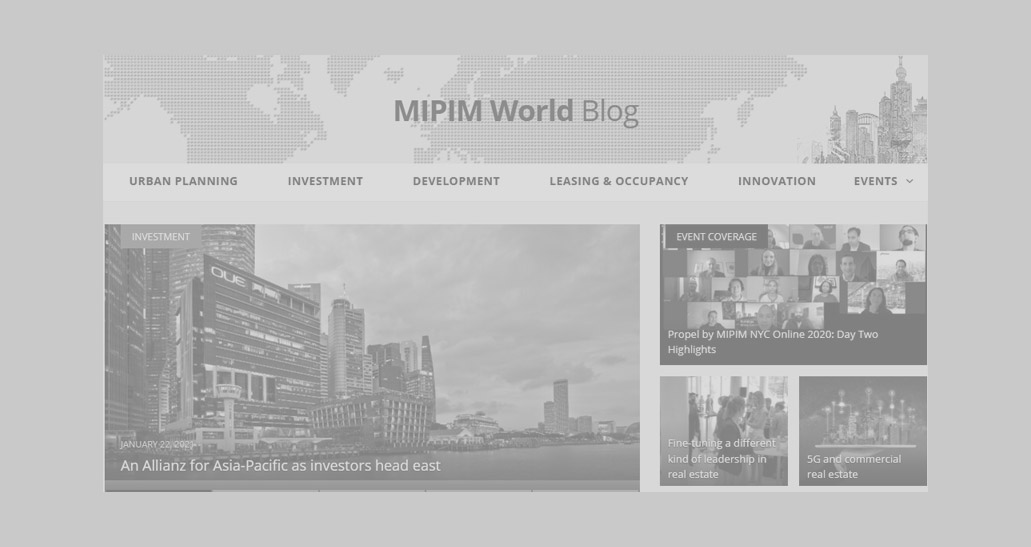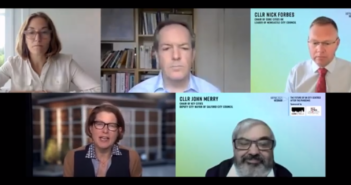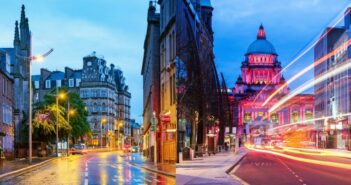This month series of blogs will cover city branding. There is now a global conversation on cities and branding that is worthwhile reviewing. We know that cities have reputations and identities that they want to protect and enhance, but does this mean that city branding will work? And is city branding a different activity from product or company branding?
Building a lasting city identity and reputation is one of the profound, but often mysterious goals that city leaders face. If we can build a city identity that is attractive, powerful, commanding affection and wonder with a sense of belonging, confidence and trust, that identity will help us to solve many of the other challenges that cities face. A positive identity can give us the ‘benefit of the doubt’ when choices are made; it can maintain outside interest in our city even when we go through rough times and compel people to help us even without evidence of their own likely return. A positive identity also makes investors and firms reluctant to leave us even when competition is fierce. A city identity helps people to embrace the soul of the city and to become a friend, not just a customer.
Twenty five Years ago we thought that cities needed brands largely in order to attract tourists. But now, in 2011 we realise that much more of the content of what makes up a city is mobile, and is contested through international competition. For example, these days it is not just tourists, but also students, researchers, innovators, investors, entrepreneurs, knowledge workers, institutions, sports and business events, film shoots, festivals, summits, technology facilities and a host of other activities that are mobile. Cities do compete to win or retain such activities. It is not enough for a city to have a brand that attracts tourists, cities must have an identity that reaches across different markets and customers and tell a unifying story about the value the city can add to the activity that is looking for a home. We cannot tell one story to the students and another to the business people, for example, because the students may become business people, and the business people sometimes also study. We need an organising story across many markets, not just a sales campaign within one of them.
Looking at the competition to host Olympics Games and World Cups is very instructive. Increasingly we hear that: ‘the city with the best technical bid was not the winner’. The untold rule is that the technical bid is only part of the process. The identity and story that the bidding cities present are also a major part of the communication. At the heart of this is always how effective the cities are in aligning their own identity with the identity of the event itself. The cities that win demonstrate and communicate shared values, aspirations, concerns, and priorities with the event organisers, not just through technical submissions, but also through personality.
London won the Olympics for 2012 without the best technical bid. Barcelona did not make a strong case to be Capital Secretariat of the Mediterranean Union but was given the role anyway, despite a strong bid from Marseilles. Once Brazil bid for the FIFA 2014 World Cup, the others realised they could not win. Some places simply have such strong identities that they have a head start in competitions of this kind.
Having a clear identity means that a city can align its identity with the identity of others and create a powerful sense of alliance, compatibility, and shared destiny. So, without a clear identity is hard to win the contests for mobile activities.
This does not just go for hosting global events. Exporting a city’s business products, attracting inter-governmental funding, and becoming the location for a film shoot or summit are also subject to the basic and primary law of relationship building, and the emotional communication that goes with it.
A city identity can also be a collaboration mechanism for the many stakeholders in a city that want to show what the city can do as well. Without a common city identity there is only the individual stories of each separate organisation or each individual, and this is too diffuse to communicate with confidence. Cities need one song even if they have many voices.
So what do the successful cities do to find and to communicate their identity. What are the habits of success that make cities winners in the personality war that happens between cities, often unnoticed? Steven Covey’s wonderful book[i] taught us that here are always seven laws of success, and here they are:
1. Prioritise City Identity and Reputation
Almost obviously, cities must prioritise this kind of thinking, and way of communicating and relating with the rest of the world. Deciding to build an identity and a reputation is an important step that moves cities away from simply providing services and infrastructures into the realm of ‘winning friends sand influencing people’.
This is difficult to do because media, political opposition, and citizens are sometimes sceptical about the value of city identity. City mayors face ‘trial by headlines’ if they spend too much on a logo, a strap line, or hosting an expensive event. But prioritisation of this way of working also means doing things the right way and doing them well. It requires deep thinking, analysis, and wisdom. There are good ways and bad ways to do it and you must know the difference. The bad ways are an expensive waste.
Singapore and Abu Dhabi have invested decisively in building globally appealing identities that have won them extensive popular interest and support, because their identities are based on deep self knowledge and a rigorous assessment of what the world wants now and will seek in the future.
2. Know our city deeply.
The first task for a city leader is to know our city, to know ourselves. This means connecting past, present, and future and understanding the origins of the city, the journey it is on, the people who have made it, the decisions that were taken, the values and vision that led the city in the past, and the role the city has played, and can play, in the lives of the people who live here, or visit. The unique story of the city must be clear and be well told.
Many cities have more than one story, cities have the ability to simultaneously be different things, they can offer great ‘alternatives’ in unique combinations. They can accept and integrate ambiguity. Consider Jerusalem or Istanbul.
It is essential to be honest and robust, to see history fully, and to know precisely, the unique characteristics that our city has. We must celebrate the city in order to see what lies behind the history. We have to know and articulate the DNA of the city.
Cape Town hosted the 2010 FIFAS World Cup along with other South African Cities. Despite a history of colonialisation and racial strife, Cape Town emerged as a distinctive and diverse city with great spirit and purpose, and an extraordinarily diverse population and appeal, well placed to leap forwards in the next 20 years.
3. Know other cities very well
Knowing ourselves also means knowing others very well, and being willing to be humble; to see that others are better than us in some respects and we have to learn. Unless we deeply understand the strengths of other, it is hard to see our weaknesses. City leaders often say that reading the many city rankings and indexes is partly about seeing how their city is doing compared to others, but also, importantly, it is about seeing which other cities are making progress and doing well, so that we can learn from them.
Knowing and understanding the strengths of other cities is key, but it is also essential to know what mobile investors and talents want. What does the demand side really tell us? What do they need, how can we communicate our offer? For many cities the failure to understand their offer from the informed perspective of understanding global demand is the big weakness: they cannot see themselves ‘from the outside in’ because they do not know what ‘the outside’ is thinking.
Our Swiss Cities have learned a great deal about what makes a successful location for advanced industries by studying what others are doing. Look at the work that Basel has done to understand what are the ingredients for successful pharmaceutical locations and we see an example of the science of understanding both the global demand, and the global best practice.
4. Build a family for the city
A city is a dispersed network of different organisations that make up its governance and its stakeholders. The city government is one of these, but does not have a monopoly over resources or assets, and it must therefore be a good leader of the others. The city government must build a family of organisations where each have their own identity but are a part of the collective identity that is the family. This is not easy, key organisations and stakeholders are also part of other families (like global firms, national or regional governments, sectored institutions, etc). They have other loyalties too. They use different ‘surnames’ and cannot see themselves as members of the city’s family too easily. But they must be ‘adopted’ and this often means that the city must also become part of their other families too, making a contribution to success of that family into the bargain.
Amsterdam and Berlin have built ‘partners clubs’ to manage their identity and brand. Amsterdam Partner and Berlin Partner own and manage the ‘I Amsterdam’ and ‘Be Berlin’ identities on behalf of a large family of followers. These organisations co-opt ‘partners’ into their city identity family and share resources with them.
5. Make the city’s promise personal
Once a clear identity emerges and is crystalised, and we know what the outside world is looking for, it is essential to make it personal for people we want to attract, or retain, in the city. Institutions and companies and events are led by people. This means knowing what part the city cam play in their success or wellbeing and showing how effectively we can add value to them. Our city might be a place of opportunity, a melting pot, a junction box, or an open city with freedom of thought, or it might have deep entrepreneurial spirit, or a place of invention, a sanctuary or haven, a seat of learning. It may be many of these things. The city’s personality comes to life when we describe what it can offer to others in ways that are meaningful to them. How it can be a friend to them? How can the city help them fulfil their potential or aspirations?
Barcelona’s initiative ‘Do it in Barcelona!’ is not just a way to attract entrepreneurs, it is way to suggest that Barcelona provides a special platform for entrepreneurial success.
6. Renew the city and align the experience with the identity.
The fabric of cities can get worn or depleted. People grow tired of tourists or the road and rail networks become over used, or the service goes bad. This is normal, and to be expected. But once we have city identity, we have also made a promise that our city will be the way we say it is. It is essential therefore to consistently upgrade, renew, and refresh the experience that people have of our city. Identity and reputation will help us get the extra good will we need for a while, but in the end the experience of city must be aligned with our story. We need the whole family to help us do that.
We must therefore solve problems rigorously as they arise and get the point where we prevent problems from emerging because we know we are protecting our identity from corrosion or sabotage. Maintaining a good climate, having open access, and good infrastructure will all require consistent attention. We cannot just focus on promoting the assets; we must keep the climate good.
When New York fixed its crime problem in the 1990s, it was renewing its identity as a great city for people and entrepreneurs, and it has not looked back since.
7. Build of the next generation of the city with integrity and consistency.
Building a city identity is a long term game. The rewards come in the longer term but they build up over time. So city leaders must be recognised for the ‘lap they have run’ and not be encouraged to try to win the gold medal before the race is over. ‘Quick wins’ must never be taken at the expense of long term gains. Because a city identity builds up over time, it is a legacy that is given to the next generations, and city leaders should be judged, not by whether they got immediate return, but by whether the identity and reputation improved under their leadership. City leaders can rest assured that their part in history is secure if they move the city forwards.
Turin has had two great leaders since it fought back against the industrial crisis in the early 1990s. Both Valentino Castellani and Sergio Champiarino have built the city identity and renewed its offer, and those who follow will do the same. Turin is on a long term road to recovery that will take several business cycles to complete. So it is too with emerging cities. Sao Paulo can be the most important city in the Southern hemisphere, but it is not there yet, so patience will be required.
Overall, we know that city identity can be an essential asset for city builders, and it is not possible to succeed if we ignore it. But getting there requires great skill and a willingness to work hard at it consistently.
One big challenge that cities face comes from the dominant role of national governments. In the last century Nation States offered an important identity for making choices between competing alternative locations for mobile activity. In this century, we know that cities and metropolitan regions offer the competitive platform that nations need, and yet some confusion between national identities and city identities abounds. Is Hong Kong a Chinese city or not? How English is London? Is Milan part of Italy or a reaction against it? Will Mumbai or Delhi be India’s great business city? These ambiguities have to be finessed so that National Governments can help to build and promote city identity, and reinforce the promise that they make, and the dividend they provide to the country as a whole. Aligning national and city identities is a key challenge for our next decade.
A city identity is not enough to succeed on its own, but it is an essential ingredient. Cities must also have ambitious and capable citizens, good services, healthy governance, efficient infrastructure and resource management and a good climate for investment. These things have to be brought together with wise strategy and a strong base of support.
Cities have to manage change, adjust to dynamic trends, and shape the future. But without city identity this both much harder to do, and the outcome is less effective. The key point is this, identity does not just us to sell our city, it is also critical to shaping and building our city, providing for city leaders the magnet that can combine people and institutions together in a common identity and purpose. What we call city leadership is a more pressing imperative than most of us are willing to say. Only by narrating the deep story of how the cities can be the leaders of the 21st Century, as they were in centuries past, can we discover their future role in leading nations and citizens to the next frontier.
Image: Flickr-Ed Coyle Photography



